Some things to consider when choosing a starting system
One of the primary reasons to make the move from pre-configured synthesizers to patchable modular synthesis is the ability to create your own instrument – be it to pick and choose your favorite flavors of synth building blocks (wavetable oscillator with a 303-like filter, anyone?), to expand it in ways you prefer (more LFOs! more envelopes!), or to explore new signal paths and configurations.
A common question is: Where do you start? A large part of the answer has to do with your comfort zone: Do you prefer to venture out from a safe starting point, or feel more creative when thrown into the deep end? There’s also some balancing required between short term and long term goals for building and using your system.
oeeeping in mind there’s no single right answer (and very few wrong ones), here are a few different approaches and their potential trade-offs. Most are all analog or analog-based, unless otherwise noted.
Starting with a semi-modular voice
This approach will give you the greatest instant gratification, and make the transition to modular easier to grasp. It can also be initially more cost effective. However, taking the easy way starting out may mean you may bump up against some limitations later.
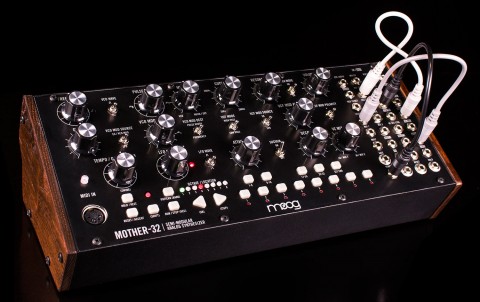
Moog Mother-32 (photo used courtesy of Moog Music)
Semi-modular synth “voices” contain a collection of the modules you need to create sounds behind a single panel. They are pre-patched like a conventional synthesizer, allowing you to get useful sounds out of them faster with a shorter learning curve. What makes them “semi-modular” is they also include patch points on that unified front panel that allow you to route the internal signals to external modules, bring external signals in, and in some cases override the internal wiring. The downside is not every possible patch point is necessarily made available, so you might encounter some ideas you want to pursue but cannot thanks to their predetermined internal wiring. Also, some will say that there is a danger of becoming complacent and relying on their predetermined signal paths rather than challenging yourself to come up with new approaches to creating sounds. That said, I still think it’s an excellent way for many to start out. You have plenty of choices in this area, and they tend to be excellent values.

Roland System-1m

Arturia Micro-Brute
The easiest approach is to get a semi-modular that works as a stand-alone instrument as well. Three popular choices include Roland’s digital System-1m ($599), Moog Music’s Mother-32 ($599-679), and the Arturia Microbrute ($349). All can initially be used as MIDI-playable self-contained tabletop units without additional expenditure. You can then later patch them into a modular unit for expansion; the Moog and Roland can even be mounted into a Eurorack-format case alongside other modules. The Arturia also has its own 2-octave keyboard, although its patching options are more limited than the Roland and Moog.
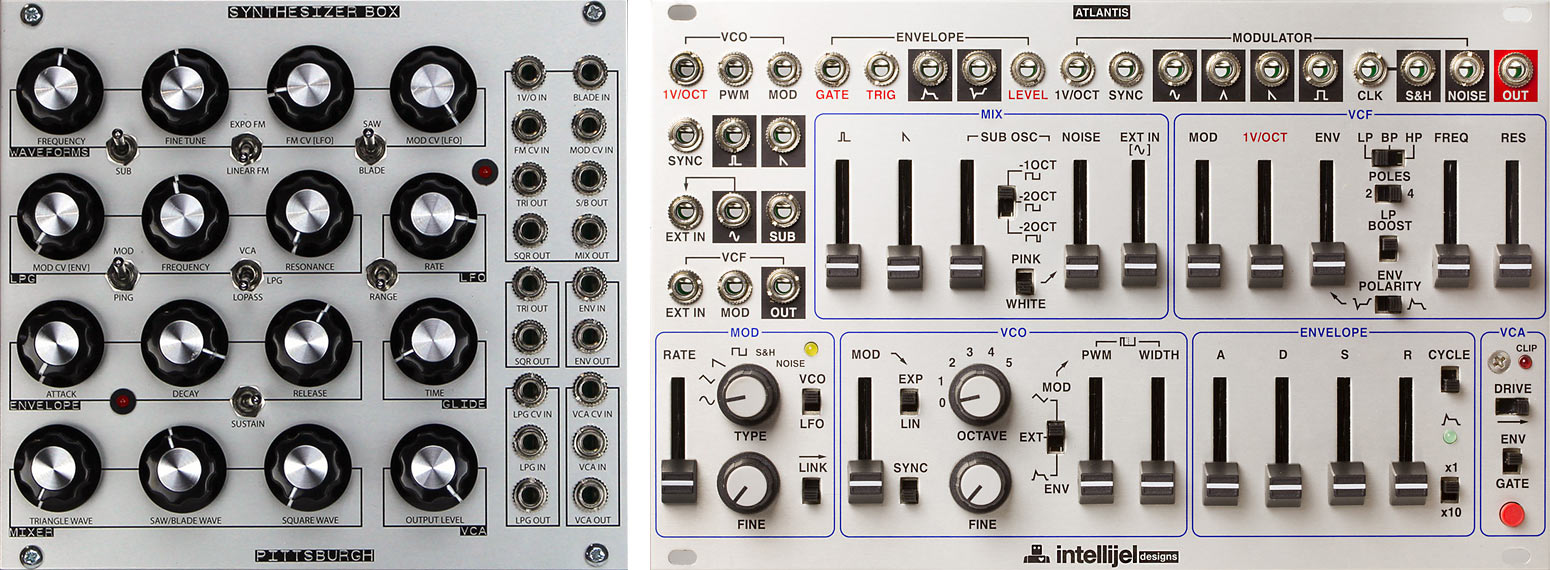
Pittsburgh Modular Synthesizer Box; Intellijel Atlantis
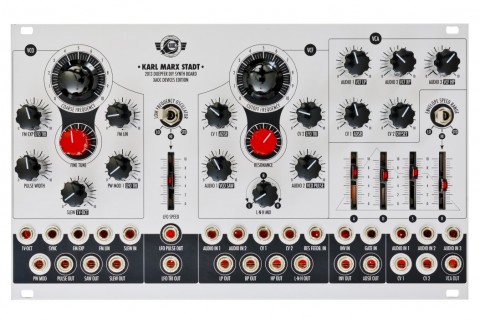
Xaoc Devices KMS (based on Doepfer DIY Synth)
Another approach is to start out buying a modular case and power supply from the beginning. This means you’ll have room to house a semi-modular starting voice, then expand its capabilities as soon as you are ready. There are many full-voices-in-a-module to choose from. Two popular choices for starter voices used to include Pittsburgh Modular’s Synthesizer Box ($399) (since replaced by their Lifeforms SV-1) and the Intellijel Atlantis ($699). An attractive alternative is the Xaoc Devices KMS ($440), which provides a nice user interface and patch points for the Doepfer DIY synth; a great value is the AtomoSynth Koe ($275). An interesting higher-end alternative is the MacBeth X-Series Micromac ($1600), which is available as a desktop unit or as a Eurorack-format voice module to install into a case. Just be prepared to spend a few hundred on your case and power supply in addition to the cost of the starter module – that’s the entry fee for investing in your future.
Again, these all-in-one starter voice modules are great value and provide a good entry point to modular synthesis, but you might feel the itch to expand sooner rather than later. For example, the Mother-32, Synthesizer Box, and KMS/Doepfer have only one oscillator, whereas many prefer using two or more; some also prefer envelopes with more segments such as a four-stage Attack/Decay/Sustain/Release over the Koe’s and Mother-32’s Attack/Decay or the Synthesizer Box’s Attack/Decay/Release; some may prefer different filter options than come with a preconfigured voice. And with the exception of the standalone units mentioned earlier, you’ll also need a way to get notes into the system to play it; a MIDI to voltage-and-gate converter is the most common path, although if you are computer-based there’s some fascinating alternatives to MIDI available such as Expert Sleepers’ Silent Way system.
Starting with a fully modular system from one manufacturer
This approach means buying a pre-selected starter collection of modules from a manufacturer with a case and power supply. This will give you a fully-patchable set of modules that will work together harmoniously (although modules of the same format tend to follow the same interconnection standards, there can be disagreements on voltage ranges, sound level clipping points, and the such). Also, different manufacturers have different mindsets; buying a complete system from one manufacturer is more akin to buying an instrument than just a collection of modules (read this Alessandro Cortini interview for affirmation of this approach). This approach tends to cost more than buying a semi-modular synth voice, but these systems are often more fully equipped as well. Note that all of the system prices in this section include the case and power supply, and the modules are already installed and tested for you. In short, going this way means jumping into deeper water as your starting point, but you probably won’t drown as the number of potential hazards has been reduced by getting a pre-configured system.
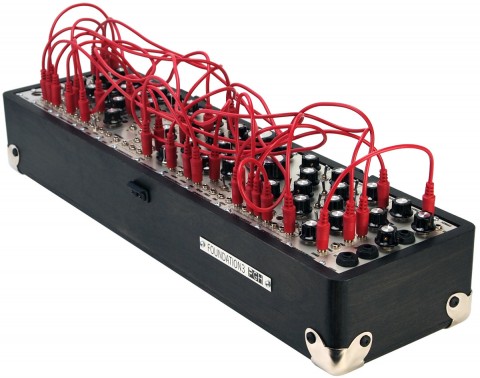
Pittsburgh Foundation 3.1
The fully patchable approach for a starter system is indeed either a plus or a minus, depending on your point of view. These systems can be daunting to someone who has never patched a modular synth before, requiring some time spent down blind alleys and dead ends before you get it to “work.” (That’s why I’m creating an Introduction to Modular Synthesis course for Lynda.com in early 2016: to shorten that learning curve, or at least make it less frustrating.) The upside is the happy accidents you’ll encounter along the way are actually among the attractions of going modular – you can’t help but to learn alternative approaches to synthesizing sounds. Some users go as far as to suggest that by going full modular from the start, you’ll avoid potential ruts from thinking along the lines of pre-configured signal paths and potentially limited patching options that you might encounter with some semi-modular systems.
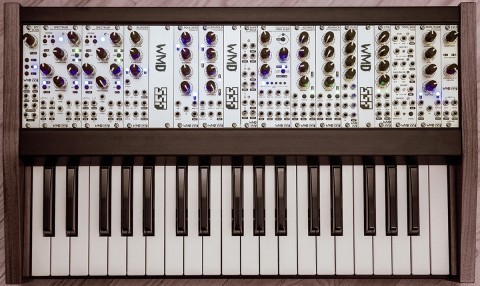
WMD/SSF Monolith
Again, you have several choices for starter systems if you decide to go down this route. Doepfer – who pioneered the popular Eurorack formula – has several Basic and Starter Systems they recommend ranging from roughly $1649 to $2599. Pittsburgh Modular also has a series of Eurorack systems ranging from $799 to $2499; look under the Synthesizers menu on their web site. Many modular synthesists today have cut their teeth on Pittsburgh and Doepfer systems. A very interesting alternative is the WMD/SSF Monolith ($2600), which contains a nice set of 15 fully-patchable Eurorack modules (plus some room to expand) packaged with a 3-ocatve keyboard.
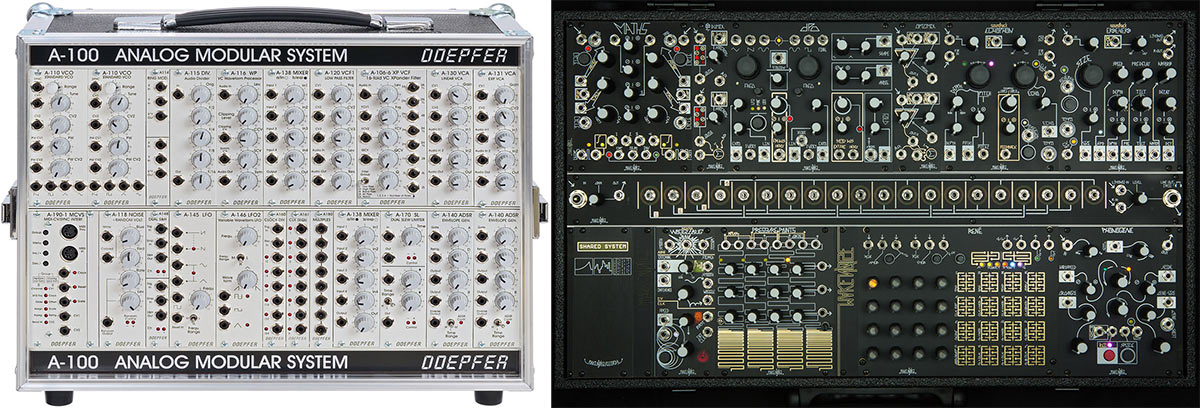
Doepfer Basic System 2; Make Noise Black & Gold Shared System
If you are of a more experimental bent, there are several manufacturers who like to stretch the boundaries of traditional synthesizer systems. For example, The Harvestman offers an “Industrial” system for those who like a bit of grit and noise, as well as an “Iron Curtain” system based around the Russian Polivoks synthesizer – the panel graphics are even in Cyrillic! Another company that encourages you to think outside the traditional box is Make Noise, who offers systems from well under $1500 to $4495, including those designed for processing sounds or controlling other systems. Both of these manufacturers are not afraid to liberally mix digital technology with traditional analog synth designs.
If you have the inclination and budget, there are also some interesting choices for professional pre-configured systems in formats other than Eurorack. Synthesists who fall into the more traditional “East Coast” or “Berlin School” electronic music can buy a reissued classic Moog System 15, 35, or 55 ($10,000 to $35,000) as well as compatible systems from the likes of Synthesizers.com ($1705 to $15,225). If you fall into the more experimental “West Coast” school, you may be drawn to systems available from Buchla Electronic Musical Instruments ($2499 to $29,999).
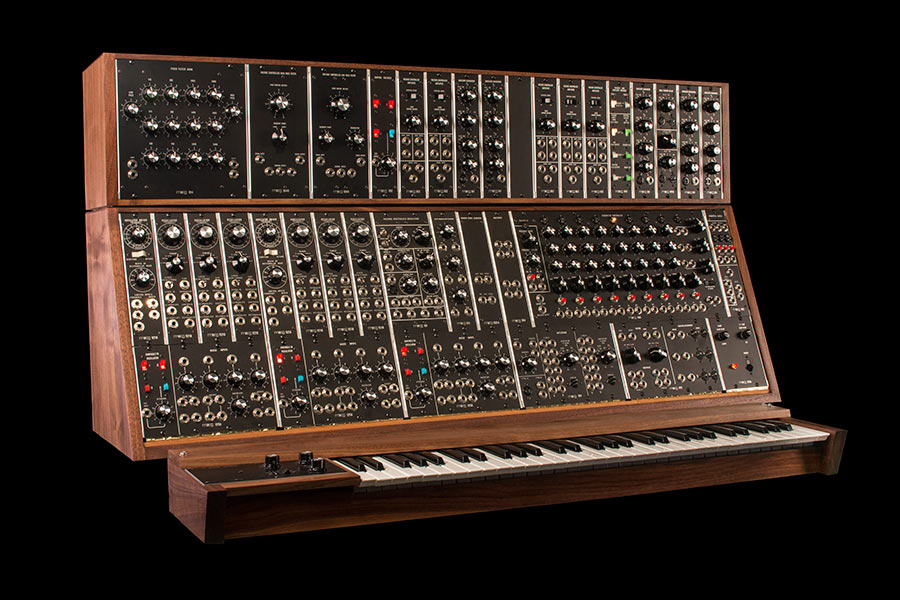
Moog System 55 (photo used courtesy of Moog Music)
Start by assembling a collection of modules from different manufacturers
This approach is the equivalent of starting out where you hope to end up in a year or so. Before you can even patch together your first synth voice, you’ll also need to learn what module choices are out there (as well as cases and power supplies), make some hard decisions and educated guesses on which modules you think you’d prefer, and assemble a system from scratch. As you can see just from the choices mentioned in this article, there are many manufacturers creating modular synths today from around the world, so you won’t be hurting for choice; you can even build your own modules from scratch, or using pre-etched circuit boards with instructions. The nice thing is you can also build the system slowly over time as funds become available, instead of having to save up to purchase a complete system before you can have some fun (or at least start learning).
Before you do get started building your system, I strongly suggest you spend a few months researching: explore what’s available from the stores that specialize in modular systems, follow forums like Muff Wiggler, and join the discussion on Facebook pages such as The Muff Wigglers and Eurorack Synthesizers. Fortunately, many other users are happy to lend advice as you share your proposed system (which you can trial-build on ModularGrid.net).
Despite your best attempts to educate yourself beforehand, you will also need to be flexible and to tweak your plan as you go when you inevitably discover you left something out, or decide a particular module just isn’t doing it for you (fortunately, there’s a good market for used synth modules). In exchange for this effort, this approach provides the opportunity of creating a versatile system you get to use virtually from day one rather than building it up as you outgrow an existing system.
My “Teaching Rack”
For the starter system I’ve been configuring for the Introduction to Modular Synthesis course I’m creating for Lynda.com, I’ve adopted a hybrid of those last two approaches to create a powerful system that covers most of the bases and still fits in 6U of 19” rack space. Once you add in the rack rails/ears, a rack case, and price of the MIDI interface, it’s around $4000 list – but you don’t need everything I’m including to get started:
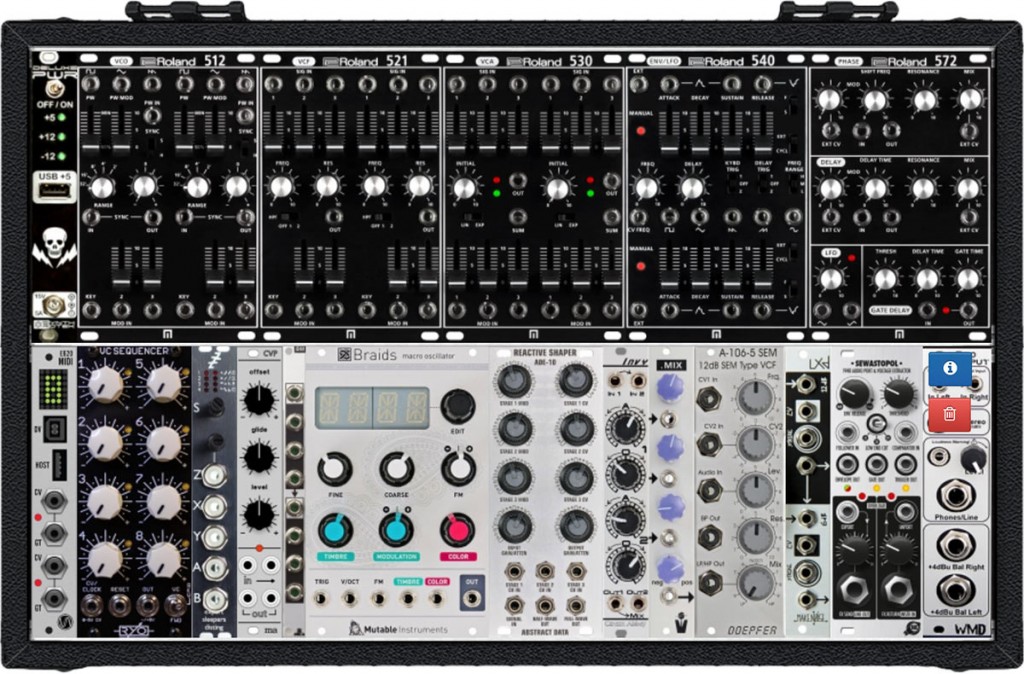
The system I will be using for “Introduction to Modular Synthesis”
For my core, I’m currently planning on using one each of the new analog Roland System-500 modules, as they are well designed as a set and nicely cover the classic East Coast/Berlin School approach. This is a good single-manufacturer starting system by itself.
Then I’m expanding the Roland core with a variety of modules from other Eurorack manufacturers to flesh out the capabilities of this core, including different ways of playing notes (both MIDI and a classic sequencer), getting sound in and out (including a headphone amp and an effects loop), providing variations on the theme (a versatile digital oscillator compared to the analog Roland; a filter that’s different in character and specification than the Roland), and taking it into more experimental “West Coast” territory (a waveshaper, low pass gate, and more), as well as including important utility modules.
Even though I have a lot of prior experience with modular synths, I still spent several months thinking, researching, and chatting with other users before arriving at this point. This system was still being built when I wrote this article; here is a an article on the finished system and the rationale behind the module choices I made.
I’m curious to hear your own opinions and experiences in creating your own starter system! That’s one of the great things about the modular synth community – many of your fellow modular musicians are more than happy to share as well as learn from each other.


Very nice write-up! I’m excited to get started. I was thrilled by the thought of using Metropolis + Atlantis + something more like Peaks or Maths to get my feet wet with eurorack. Stumbled upon so much information weighing out the implications of my most basic plan, with so much room to grow. What an exciting & ever-ending hobby!
Thanks – very helpful overview. As ever, a classic trade-off between price and performance/flexibility. I want to go down the Synthesizers.com route, but not sure I can afford it…